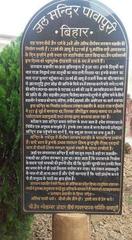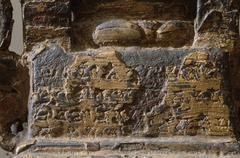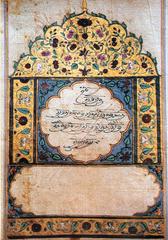
Ara–Chhapra Bridge Visiting Hours, Tickets, and Travel Guide – Bihar, India
Date: 04/07/2025
Introduction
The Ara–Chhapra Bridge, officially named Veer Kunwar Singh Setu, stands as a modern engineering marvel and a vital artery linking the districts of Ara (Arrah) in Bhojpur and Chhapra in Saran, Bihar. Spanning the iconic Ganges River, this bridge not only facilitates seamless transportation and trade but also reflects Bihar’s spirit of progress and unity. Named after the legendary freedom fighter Veer Kunwar Singh, the structure is a blend of historical reverence and cutting-edge design.
This comprehensive guide details the bridge’s history, engineering significance, practical visitor information, travel tips, and nearby attractions, ensuring a memorable and well-informed experience for all travelers.
Historical Context and Significance
Bridging the Divide
For centuries, the Ganges River was a formidable barrier between Ara and Chhapra, with ferries and circuitous routes impeding efficient movement. The demand for a direct, all-weather crossing was crucial for regional integration, economic development, and social cohesion. The Ara–Chhapra Bridge was envisioned as a transformative project to address these challenges, significantly reducing travel distance by over 60 kilometers and supporting seamless connectivity between National Highway 19 (NH-19) and National Highway 31 (NH-31) (Wikipedia: Arrah; S.P. Singla Constructions).
Honoring Veer Kunwar Singh
The bridge’s name pays homage to Veer Kunwar Singh, a prominent leader in the 1857 Indian Rebellion, connecting Bihar’s illustrious past with its dynamic present (Wikipedia: Arrah).
Engineering Marvel: Design and Construction
Record-Breaking Structure
Veer Kunwar Singh Setu is the world’s longest multi-span extradosed bridge, with a main span of 1,920 meters. The extradosed design—merging aspects of girder and cable-stayed bridges—allows for longer spans, reduced piers in the river, and minimal environmental impact (Wikipedia: Arrah; Academia.edu).
Key Features
- Total Length: 4,350 meters
- Width: 20.5 meters (four traffic lanes)
- Superstructure: 15 spans of 120 meters each, built with precast segmental construction
- Foundations: Massive 6–7 meter diameter wells, built to withstand strong currents and seismic activity
Construction Timeline and Challenges
Construction began in the early 2010s under S.P. Singla Constructions Pvt. Ltd. The team navigated challenges such as monsoon flooding, logistical hurdles in transporting heavy materials, and stringent environmental regulations. The bridge was completed and opened to the public in June 2017 (S.P. Singla Constructions).
Socio-Economic Impact
The Ara–Chhapra Bridge has revolutionized the region by:
- Enabling Trade and Commerce: Streamlining the movement of goods and agricultural produce, thus lowering costs and boosting local economies.
- Promoting Mobility: Offering faster, safer access to educational, healthcare, and employment opportunities.
- Fostering Regional Unity: Enhancing cultural and social ties between communities on both sides of the Ganges.
- Supporting Festivals and Events: Particularly during events like Chhath Puja, the bridge facilitates pilgrim access to riverbanks (OhFact: Bihar).
Visitor Information
Visiting Hours and Ticket Policy
- Hours: The bridge is accessible 24/7 for vehicles and, where permitted, for pedestrians and cyclists.
- Entry Fee/Ticket: There are no entry fees or tolls. Access is free for all.
Accessibility
- By Road: Directly connects Ara and Chhapra via NH-19 and NH-31; regular buses and taxis are available from Patna, Ara, and Chhapra.
- By Rail: Nearest stations are Ara Junction and Chhapra Junction.
- By Air: The closest airport is Jay Prakash Narayan International Airport in Patna (~90 km away).
- Parking: Limited parking near bridge approaches; it is advisable to use public transport where possible.
Safety and Guidelines
- Pedestrian Access: Designated walkways exist but may be limited; always follow posted safety instructions.
- Best Time to Visit: October to March offers pleasant weather; avoid the monsoon season (June to September).
- Photography: Sunrise and sunset provide the best lighting for panoramic photos.
Travel Tips
- Carry drinking water and snacks if you plan to spend time sightseeing.
- For the best experience, visit during daylight hours (6:00 AM to 6:00 PM).
- Avoid crossing during adverse weather or maintenance activities.
Nearby Attractions
- Arrah (Ara): Visit the Arrah House Memorial, explore local markets, and experience Bihari cuisine.
- Chhapra: Enjoy the historic Sonepur Cattle Fair, temples, and riverside parks.
- Cultural Sites: Bihar is rich in heritage, with sites like Bodh Gaya and Nalanda accessible by road.
- Other Infrastructure Landmarks: Explore projects like the Koilwar Bridge and Kacchi Dargah–Bidupur Bridge.
Visitor Experience
- Scenic Views: Panoramic vistas of the Ganges and vibrant river life.
- Engineering Highlights: Observe the unique extradosed design, including stay cables and piers.
- Photography: Bridge mid-span and riverbanks are ideal locations.
Frequently Asked Questions (FAQ)
Q1: Is there an entry fee or toll for the Ara–Chhapra Bridge?
A1: No, the bridge is free to cross for all vehicles and visitors.
Q2: What are the visiting hours?
A2: The bridge is accessible 24 hours a day; daylight hours (6:00 AM–6:00 PM) are recommended for sightseeing.
Q3: How can I reach the bridge?
A3: Easily accessible by road, rail, and from Patna airport; public transportation is widely available.
Q4: Can I walk on the bridge?
A4: Pedestrian access is generally allowed where designated, but safety guidelines and restrictions may apply.
Q5: Are guided tours available?
A5: No official tours, but local operators may provide broader tours including the bridge and nearby attractions.
Plan Your Visit
To make the most of your trip:
- Check local weather and travel advisories.
- Explore historical and cultural sites in Ara and Chhapra.
- Use the Bihar State Tourism Development Corporation and the Audiala mobile app for up-to-date information.
Visual Gallery (Suggestions)
- Include images of the bridge at sunrise and sunset with appropriate alt tags (e.g., “Ara–Chhapra Bridge at sunset over the Ganges”).
- Maps showing location and access routes.
- Close-ups of engineering features such as cables and piers.
Further Resources and Official Links
- Wikipedia: Arrah
- S.P. Singla Constructions
- OhFact: Bihar
- Academia.edu: Design and Erection of the Arrah Chhapra Ganges River Bridge
- Bihar State Tourism Development Corporation (BSTDC)
- Wikipedia: Arrah–Chhapra Bridge
- Official Bihar Tourism Website
- Local Travel Information at Biharsay
Conclusion
The Ara–Chhapra Bridge (Veer Kunwar Singh Setu) is a symbol of Bihar’s advancement, cultural pride, and commitment to regional development. Its innovative design, historical significance, and practical utility make it a top destination for travelers and locals alike. With unrestricted, toll-free access and proximity to cultural and historical attractions, the bridge offers a rewarding glimpse into Bihar’s journey toward progress.
Plan your visit, explore the surroundings, and experience firsthand one of India’s most iconic river crossings!



